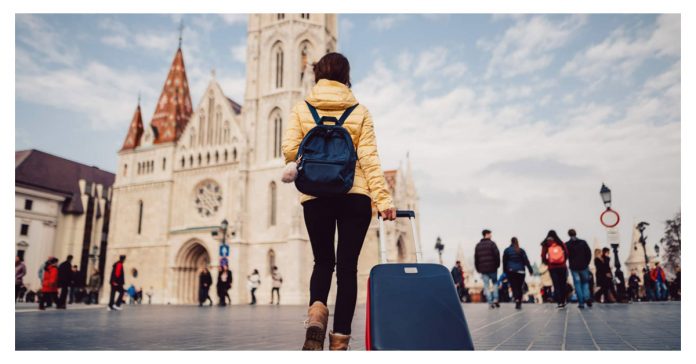Planes would emit nothing but positive vibes into the air in our ideal #zerowaste, zero-pollution world. But, in actuality, you have to get somewhere, and for many people, flying is the best choice.
Living your finest zero waste life means accepting that no industry is ideal but doing what you can within your constraints to reduce your environmental impact.
There are numerous judgment calls and steps you can take to be as environmentally friendly as possible when flying.

If possible, book direct flights
Most fuel is emitted during the flight during landing and takeoff. The fewer flights you take, the more occasional landings and takeoffs you make, the fewer fuel emissions are released into the atmosphere.
Reduce your carbon footprint
Some airlines – offer the option to buy “carbon offsets,” which essentially remove the carbon dioxide emissions you’ve contributed to as a traveller from the atmosphere in various ways, such as planting a tree.
However, please note that airlines do not always make it obvious or provide options during the ticket purchasing process. After buying the ticket, you may be directed to a stand-alone sustainability program page – but a little additional internet browsing is well worth it if you want to reduce your carbon footprint.
Pack efficiently and lightly
The more cargo a plane carries, the more fuel it must burn, releasing more carbon dioxide into the atmosphere. Though the plane’s infrastructure accounts for the majority of its weight, every little bit counts. We pack to the maximum allowed most of the time, even if we don’t need to carry that many items. Set a goal of fitting all you need into one carry-on suitcase and a personal thing.
To get you started, here are some packing suggestions:
- If possible, say “no” to travel-sized items. Instead, consider the following alternatives:
- Rather than a mini tube of toothpaste, make some ahead of time and carry it in a tiny steel container or glass jar.
- Rather than single-use makeup remover wipes, try reusable cotton pouffes and coconut or olive.
- Rather than mini bottles of body wash, conditioner, and shampoo, use bar soap and/or shampoo bar in a tin travel case.
2. Carry “dual purpose” items, such as a scarf that can be used as a blanket or a coat that can be used as a pillow.
3. To save space in your carry-on, wear your bulkiest garments on the plane.
4. Bring nothing that you don’t wear daily. If you don’t wear it at home, chances are you won’t wear it when travelling.
5. Bring items for layering. Wearing a thin tee under a sweater allows you to wear it more frequently without it becoming smelly.
6. Choose a colour palette that is neutral for your outfits. The goal is to bring items that can all be worn together to maximize the number of outfits you can wear with as little clothing as possible. Sticking to a colour palette of grey, tan, white, and black is a great way to accomplish this.
Go through your perishable food a day or two before you leave
If you’re going to be gone for a week or more, go through your pantry and fridge for perishable items and figure out how to preserve them.
- Many vegetables? Make a large batch of them and freeze them.
- Fruit? Peel, cut, and freeze for future smoothies. Make a point of composting any scraps or peels.
- Wrap meat in paper and freeze for later consumption.
- If you have anything left over, give it to your neighbours or roommates who may be staying.
- Anything else can be composted.
Before you leave, put your house “to sleep”
Unplug anything that is plugged into an outlet. Even if it is not “on” – for instance, a lamp with a switch – simply plugging it in draws energy from the outlet. Allow yourself enough time to scan your entire home.
During the wintertime, it’s best not to turn off the heat totally to avoid your pipes freezing and exploding, but rather to set your thermostat to 50 degrees to conserve power and save money on your heating bill.
Pack snacks for the flight, as well as a reusable water bottle, coffee cup, and travel utensils
Food at airports is notoriously marked up, and many snacks are encased in single-use plastic; avoid this by bringing your zero-waste snacks with you. It’s not difficult; all it takes is a little planning! Produce bags stuffed with fruit, pastries, bulk snacks like granola or nuts, or a sandwich are an excellent choice.
Remember to bring a reusable water bottle, which you should drink before going through security or leave empty. Fill it up at a water fountain right before your flight, or go to an airport bar and ask the bartender to fill it up for you. Because there won’t be drinkable running water on the plane, you’ll be able to stay hydrated without having to drink from a plastic water bottle.
If you have a long flight ahead of you and want to grab a cup of joe at the airport, bring an unfilled reusable coffee cup in your carry-on to avoid using a single-use paper cup.
Don’t forget to pack a set of travel utensils. They’re wondering if you’re staying in a hotel with only plastic cutlery for breakfast.
For the flight, dress in layers
One of life’s great surprises is the temp of a flight, so be prepared for both extremes. Avoid using an airplane blanket or pillow wrapped in single-use plastic by wearing light layers and things that can double as blankets and pillows. We recommend a large, cosy scarf that can be folded up but is warm enough to be used as a blanket.
Not only will planning and being primed and ready for your journey help you reduce your environmental impact, but it will also make your journey more enjoyable. For both you and Mother Nature, it’s a huge win!














